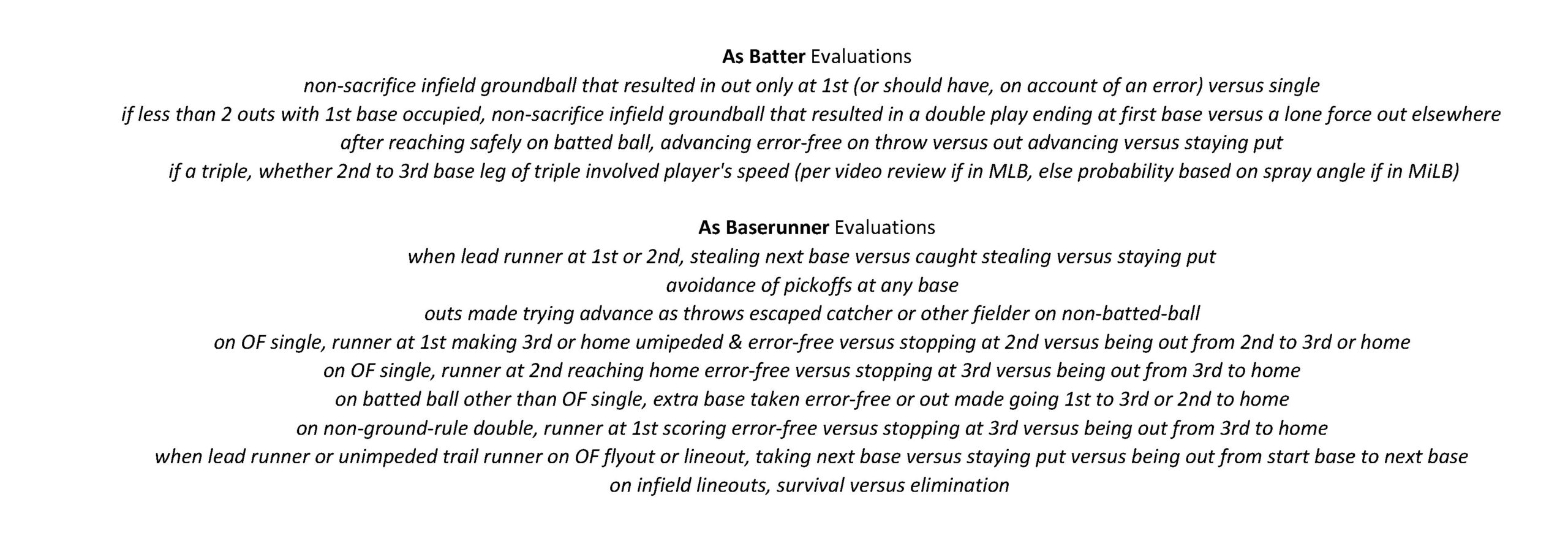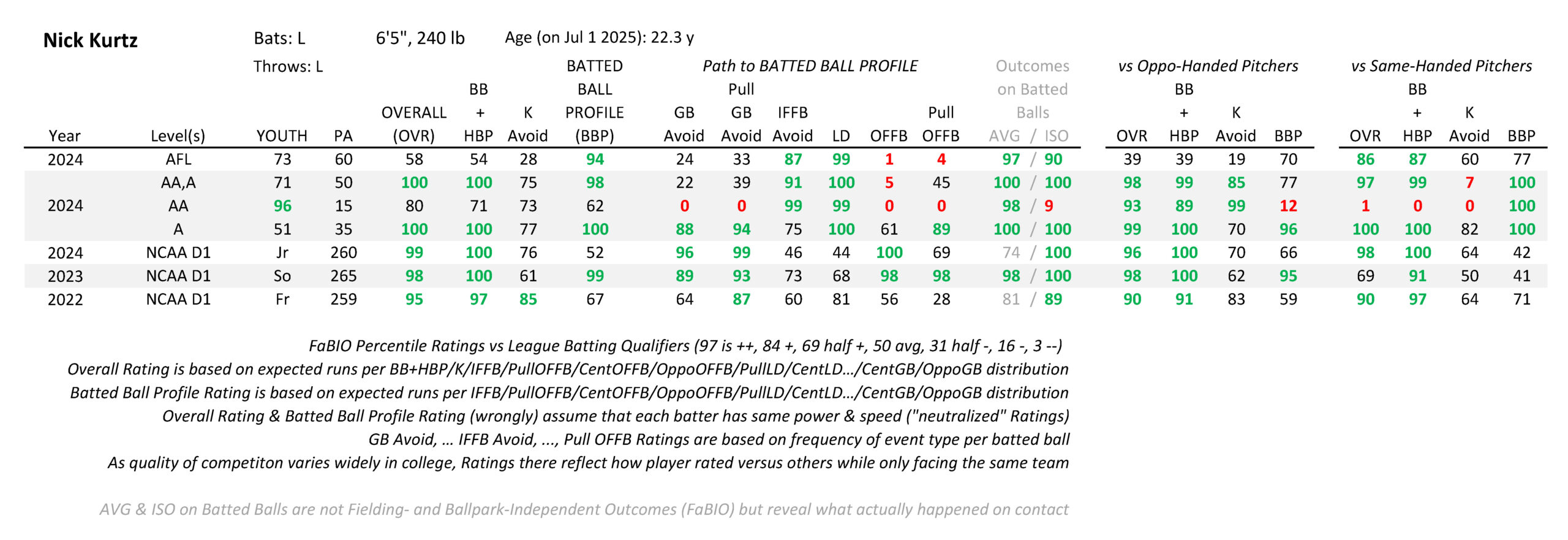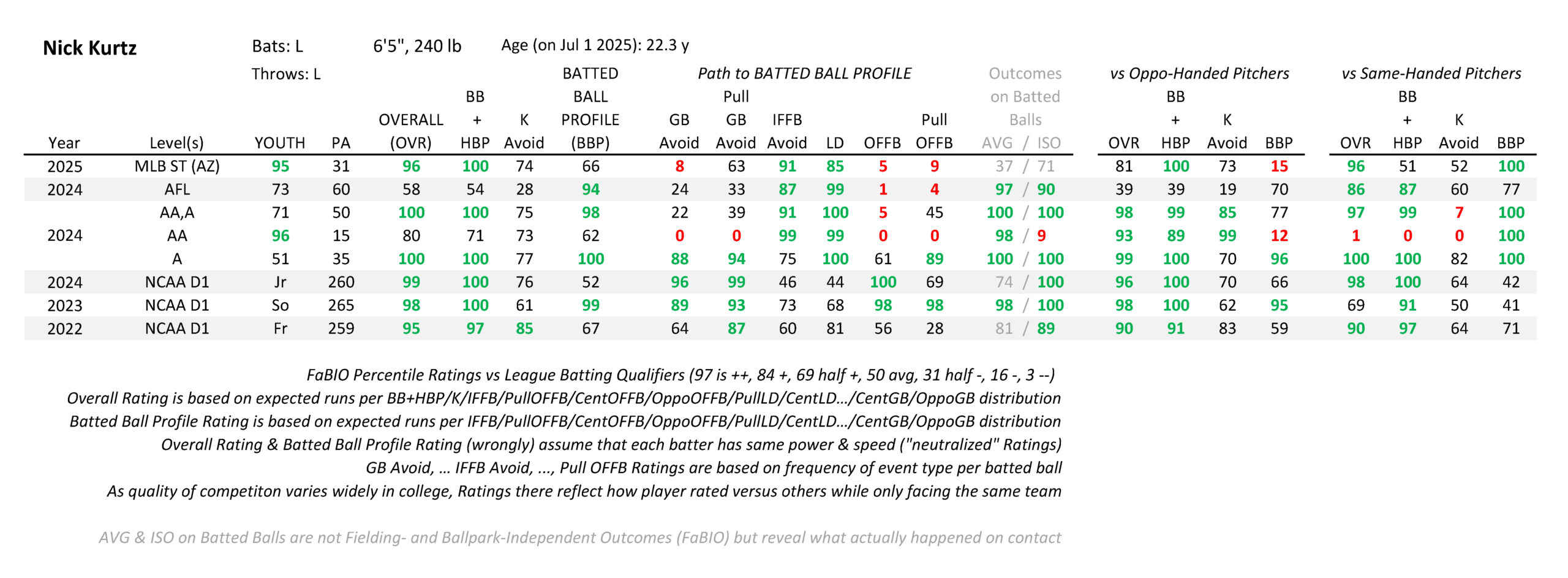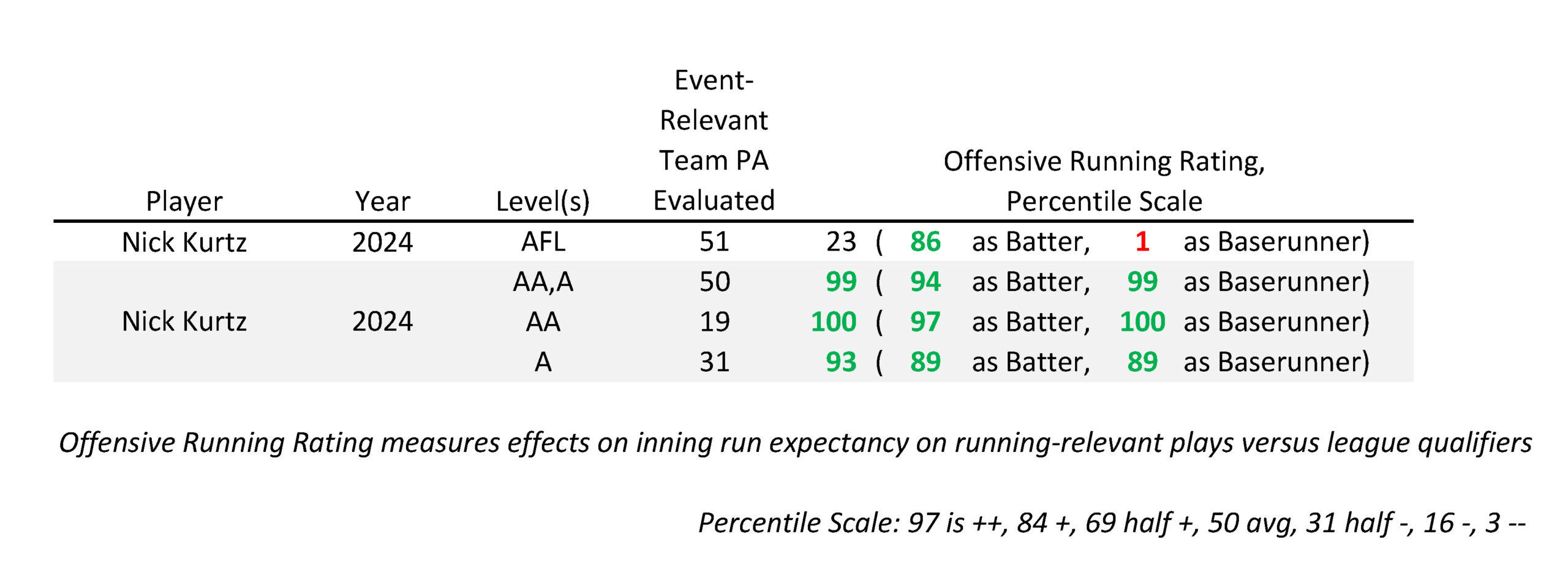Nick Kurtz's fantasy baseball prospect outlook, sleeper potential for dynasty leagues. Matt uses his custom suite of fundamentals-rooted evaluation tools.
After writing up five 2025 MLB rookie position players from the college ranks of the 2023 or 2024 MLB Draft classes (Jacob Wilson, Dylan Crews, Kristian Campbell, Matt Shaw and Cam Smith) in a similar fashion to what follows, I had planned to do the same for several other top prospect position players from that 2023 class as the next order of business.
But let us momentarily leap ahead one draft class and analyze Athletics first baseman Nick Kurtz.
I already sense that the former 2024 MLB Draft fourth overall pick will soon have MLB regular-season plate appearances to run through the FaBIO wringer before I even start processing already stale 2025 MiLB ones.
Be sure to check all of our fantasy baseball lineup tools and resources:- Fantasy baseball trade analyzer
- BvP matchups data (Batter vs. Pitcher)
- PvB matchups data (Pitcher vs. Batter)
- Who should I start? Fantasy baseball comparisons
- Daily MLB starting lineups
- Fantasy baseball closer depth charts
- Fantasy Baseball live scoreboard
- Fantasy baseball injury reports
Brief Explanation of the FaBIO Model
My Fielding- and Ballpark-Independent Outcomes (FaBIO) evaluation model sorts every plate appearance into one of 12 outcome bins (BB+HBP, K, IFFB, Pull-Third OFFB, Center-Third OFFB, Oppo-Third OFFB, Pull-Third LD, Center-Third LD, Oppo-Third LD, Pull-Third GB, Center-Third GB, Oppo-Third GB) and charges the pitcher and batter with their league's mean runs value for said particular event that season.
Dividing a batter's total number of expected runs by plate appearance (PA) yields expected runs per PA that can be percentile ranked relative to the league mean and standard deviation for that parameter amongst league batter qualifiers to arrive at their Overall Rating.
Its three subcomponents of BB+HBP Rating (based on BB+HBP per PA), Strikeout Avoid Rating (K Avoid, based on K per PA), and Batted Ball Profile Rating (expected runs per batted ball) are also reported to identify the path the batter traveled to reach their Overall Rating.
Overall Rating and Batted Ball Profile Rating of batters should be considered power- and speed-neutralized metrics since the real-world runs value of a single batter's typical OFFB or LD varies with their strength, and the expected runs value of their typical GB varies with their speed.
To better understand the Path to Batted Ball Profile, we will also examine percentile ratings for select batted ball event types (on a per-batted ball basis). To check how well expected batted ball outcomes matched real-world ones, we will compute percentile ratings for hits (AVG) and isolated power (ISO, or simply extra bases) on batted balls (recognizing full well that these two parameters are neither fielding- nor ballpark-independent outcomes).
What most explains a batter's ability to generate hits (AVG) on batted balls is any LD, IFFB avoidance, Pull-Third OFFB, and Pull-Third GB avoidance. What most explains their ability to generate extra bases (ISO) on batted balls is any OFFB, Pull-Third OFFB, Pull-Third LD, and IFFB avoidance.
A percentile rating of 97 amounts to plus-plus (two standard deviations above the mean), 84 is plus (one standard deviation above the mean), 69 is half plus, 50 is average, 31 is half minus, 16 is minus, and three is minus-minus.
A new addition to this suite of evaluation models is Offensive Running Rating. This tool quantifies how each relevant inning's run expectancy was impacted by the player's action or inaction as either a batter or baserunner on very specific types of plays that are more likely to involve one or both of their speed or offensive running technique, plus acumen.
The evaluated batter and baserunner events are summarized in the graphic.
Prospect Analysis: Nick Kurtz
Evolution of College Plate Profile
A FaBIO table summarizing three full seasons of NCAA Division I play at Wake Forest reveals disproportionately plus or better (green font) or above-average marks aside from a freshman 28 Pull OFFB and four ratings in the 40s. Per Overall Ratings, Kurtz gradually rose from the top five percent of NCAA D1 batting qualifiers as a true freshman to the top one percent of them as a junior.
Double to triple plus BB+HBP Ratings remained relatively constant over the three campaigns. His K Rating dipped from 85 as a freshman to 61 as a sophomore before rebounding to 76 as a junior. Kurtz also gradually added loft to the batted-ball profile per the ever-rising annual GB Avoid and OFFB Ratings.
Per that, LD and AVG on Batted Balls fell from 2023 D1 to 2024 D1 as OFFB were added to a batted-ball profile that was already double-plus thick in them. Kurtz likely undermined his ability to hit for AVG a few ticks without gaining much ISO. Kurtz produced lots of ISO in 2022 and 2024 D1 despite not producing Pull OFFB nearly as well relative to D1 peers as he did OFFB relative to them.
This affirms that Kurtz has considerable all-fields power and is far less dependent on pull-thirding OFFB to generate extra bases than most batters are (FaBIO dings him relatively more for that than he is punished for such in the real world).
The first of the two main concerns that clouded the collegiate history was a right (non-throwing) shoulder labrum injury that required surgery and shut him down for the summer of 2022, barring him from scheduled Cape Cod Baseball League and USA Collegiate National Team play.
Another right shoulder injury sustained on a defensive dive suspended March 2024 play for two weeks.
The second factor was that Kurtz logged no wood-bat collegiate summer league experience due to the 2022 shoulder surgery and a deep Wake Forest run into the 2023 NCAA College World Series (he missed the finale of a three-game elimination series loss to LSU in Omaha with a rib injury).
However, given how fundamentally sound and physical Kurtz was at the plate in D1 play, MLB clubs were most focused on the right shoulder as the July MLB Draft approached. My pre-draft scouting report on Nick Kurtz pegged the pro for double-plus walks, half-plus strikeout avoidance, half-plus hits per batted ball, all-fields double-plus extra bases per batted ball, full-plus first base defense, and average offensive running.
Nabbing Nick Kurtz with the fourth overall pick of the 2024 MLB Draft helped cushion the Draft Lottery misfortune that had displaced the still-Oakland Athletics from the first overall spot, where their won-loss record would have placed them. The parties agreed to a $7.0 million signing bonus that netted the club $1.4 million in bonus pool savings versus slot value for the pick.
Evolution of Pro Plate Profile
In over 35 PA with the Athletics Low-A affiliate, Nick Kurtz came out of the pro gates hitting the LD and Pull OFFB, which his 2024 D1 plate profile had been shorter on while posting many a 100 Rating.
After bypassing the organization's High-A affiliate, Kurtz only hit LD and GB over 15 PA in Double-A before a first-base-stretching injury cost him the final month of regular-season games.
To make up for the missed September time, Kurtz was sent to the Arizona Fall League. That stint featured a rather down BB+HBP and K duo by past row standards. The batted-ball profile maintained a high LD and high IFFB Avoid but lower-launch bias in step with the tiny-sample Double-A ones, though Kurtz was able to generate 90 ISO despite almost no OFFB or Pull OFFB relative to circuit batting qualifier peers.
Kurtz would receive a non-roster invite to 2025 MLB spring training, and by camp's end, he had logged 31 plate appearances. A 96 Overall with a BB+HBP >> K Avoid > Batted Ball Profile bias cast Kurtz as closer to a MLB debut than he had seemed to be while in the Arizona Fall League.
Consistent with what had gone down in Double-A and the AFL, Kurtz again posted a low-launch batted-ball profile thicker in LD + IFFB Avoid. However, the MLB spring batted balls didn't generate very much AVG or ISO relative to the also-in-Arizona AFL ones.
By using the rightmost ends of all table rows, the left-handed batter has seldom shown hints of platoon defects with pitchers of either handedness type.
Evolution of Pro Offensive Running
Offensive running would not figure to be a strong suit of a 6-foot-5 and 240-pound Nick Kurtz.
But after simplifying the Offensive Running Rating table below to an as Batter Rating and as Baserunner Rating at each of the Low-A, Double-A, and AFL circuits, five of six marks are in the 86 (plus) to 100 (pushing triple plus) range, with the outlier being a mere one as Baserunner Rating in the AFL.
Just where Kurtz slots best among offensive runner qualifiers should become clearer over a larger sample of 2025 pro play. It would be safe to assume that he is not a double-plus (97) offensive runner, come then. But per that, this is one of the most fundamentally sound and multidimensional first baseman in the game, one ought not be surprised if he were to post a half-plus or better Offensive Running Rating.
Dynasty Fantasy Baseball Focus
We have probably not seen a L/L first baseman with this style of frame and such a complete fundamentals profile since earlier-career Anthony Rizzo.
Nick Kurtz did not return to Double-A Midland to open 2025. Instead, he landed in Triple-A Las Vegas, which makes for one of the more difficult venues from which to imagine sea-level production, given its altitude and those of several road parks of the western Pacific Coast League. Unsurprisingly, Kurtz is off to a monster start there, so much so that he will likely debut in MLB within weeks, if not days.
In the wake of 2024, which saw the batted-ball profile gradually pivot from OFFB-extreme in D1 to GB+LD-extreme in AFL and the latter bias largely spill over to 2025 MLB spring games, the 2025 version of Kurtz stands to seek a happier medium of batted-ball launch angles that promote a more balanced mix of extra bases and hits.
An educated guess would be that he settles on one that is fairly neutral in OFFB versus GB bias relative to league batter peers and just might lean more in the GB direction, per how his spring batted balls sorted out.
Whereas I had forecast half-plus hitting and double-plus power for the pro pre-Draft, it would now seem advisable to project full-plus hitting and 1.5-plus power for a 2025 MLB debut, with more power coming in subsequent seasons, perhaps at the expense of some of that higher-than-initially forecast 2025 hitting.
Download Our Free News & Alerts Mobile App
Like what you see? Download our updated fantasy baseball app for iPhone and Android with 24x7 player news, injury alerts, sleepers, prospects & more. All free!

More Fantasy Baseball Advice
 RADIO
RADIO





























